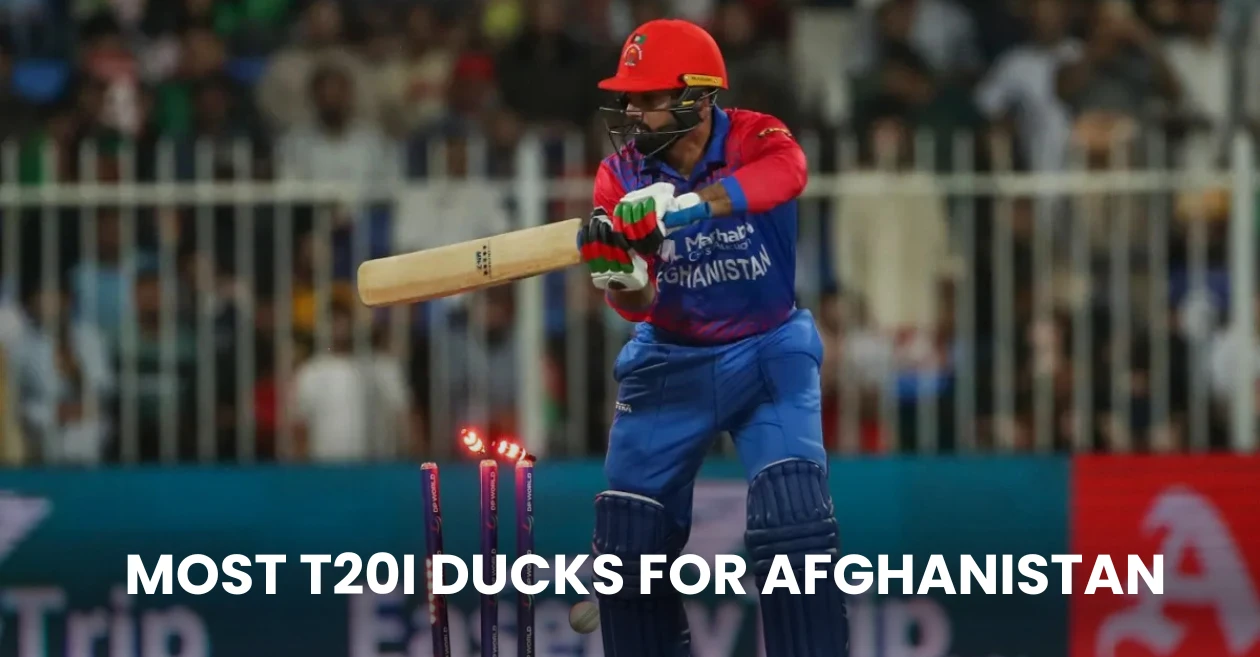Veteran all-rounder Mohammad Nabi, one of Afghanistan cricket’s most celebrated figures, added an unexpected record to his long and illustrious career — but one he would rather not have owned. The 40-year-old stalwart registered his ninth duck in T20 Internationals, the most by any Afghanistan player in the format, during the first T20I against Zimbabwe at the Harare Sports Club.
Yet, what began as a personal low for Nabi turned into a night of dominance for Afghanistan as they outclassed Zimbabwe by a huge margin, taking a 1-0 lead in the three-match series. The visitors’ performance was a statement of intent ahead of the upcoming ICC Men’s T20 World Cup, combining sharp bowling, disciplined fielding, and an aggressive batting approach.
Nabi Surpasses Gurbaz in the Unwanted List
Cricket is a game of glorious uncertainties, and even legends are not immune to its ironies. Mohammad Nabi, a match-winner on countless occasions, etched his name into the record books for a rather unwelcome reason — the most ducks by an Afghan player in T20Is.
Nabi’s latest dismissal, a two-ball duck, came when he edged a delivery from Blessing Muzarabani behind to the keeper during Afghanistan’s innings. It was his ninth duck in 143 T20Is, surpassing wicketkeeper-batter Rahmanullah Gurbaz, who has eight.
While the statistic stands out for its oddity, it also underscores Nabi’s longevity. Across 15 years of T20I cricket, the seasoned campaigner has batted in almost every situation — as a finisher, anchor, and even opener in early days — often taking on risky roles where quick runs mattered more than personal milestones.
Here’s a look at the updated list of Afghan players with the most ducks in T20Is:
| Player | Ducks | Matches |
|---|---|---|
| Mohammad Nabi | 9 | 143 |
| Rahmanullah Gurbaz | 8 | 78 |
| Gulbadin Naib | 7 | 78 |
| Rashid Khan | 7 | 106 |
| Azmatullah Omarzai | 6 | 59 |
Despite this “unwanted” record, Nabi remains Afghanistan’s heart and soul — the player who has seen the team rise from Associate ranks to full ICC membership, mentoring a generation of talent and leading the team through transformative phases.
Afghanistan’s Dominant Batting Display: Zadran Leads from the Front
If Nabi’s early exit hinted at a stumble, Ibrahim Zadran quickly ensured there would be none. The elegant right-hander delivered a masterclass in controlled aggression, scoring a fluent 52 off 33 balls, studded with six fours and a towering six. His innings balanced precision and power, exploiting gaps smartly while punishing anything loose.
Zadran’s form has been exceptional in recent months, and once again, he set the tone for Afghanistan’s innings. His partnership with Rahmanullah Gurbaz (39 off 28) was the perfect blend of stability and momentum, as the pair added crucial runs in the powerplay. Gurbaz, who narrowly avoided matching Nabi’s record with eight ducks, played freely, peppering the field with crisp boundaries.
Following their dismissals, Sediqullah Atal (25) and Azmatullah Omarzai (27) maintained the pressure on Zimbabwe’s bowlers with quick cameos, rotating the strike and finding boundaries in key overs. Their contributions were instrumental in ensuring Afghanistan crossed the 150-mark with ease.
The finishing touch came from *Shahidullah (22 off 13)**, who struck a few elegant boundaries in the final overs, guiding his team to a strong total of 180/6 in 20 overs.
Zimbabwe Falter Under Pressure
Chasing 181 on a slightly worn Harare surface was always going to be challenging, particularly against Afghanistan’s potent bowling attack. Zimbabwe’s innings never quite took off, losing wickets at regular intervals.
Only Tinotenda Maposa provided some entertainment for the home fans with a blazing cameo — 32 off just 15 balls, hitting five fours in a spirited counterattack. His effort, however, was in vain as wickets tumbled around him.
The likes of Brian Bennett (24), Brad Evans (24), Tony Munyonga (20), and Tashinga Musekiwa (16) all got starts but failed to convert them into anything substantial. Zimbabwe’s middle order lacked the composure needed to counter Afghanistan’s varied bowling attack, collapsing to 127 all out in 16.1 overs.
The 53-run defeat highlighted the gulf in consistency and skill between the two sides — especially in handling high-quality seam and spin bowling under pressure.
Farooqi and Omarzai Seal It with the Ball
If Afghanistan’s batting was authoritative, their bowling was clinical. Fazalhaq Farooqi, replacing Noor Ahmad in the squad due to visa issues, made his mark immediately. The left-arm pacer was relentless with his line and length, swinging the ball late and mixing up his pace intelligently. His figures of 4/20 in four overs dismantled Zimbabwe’s top order and effectively ended the contest within the first 10 overs.
Azmatullah Omarzai complemented him beautifully with his clever variations and sharp cutters, returning figures of 3/29. His ability to strike at key moments — including the dismissals of Bennett and Evans — kept Zimbabwe from forming any substantial partnership.
Youngster Abdollah Ahmadzai, often overshadowed by the bigger names, added to the carnage with 2 wickets, ensuring no respite for Zimbabwe’s lower order.
Afghanistan’s bowlers showcased an enviable balance — Farooqi’s swing, Omarzai’s pace, and Ahmadzai’s accuracy — all combining to produce a ruthless bowling performance that underlined the team’s depth ahead of next year’s T20 World Cup.
Nabi’s Career: Beyond the Numbers
Mohammad Nabi’s career has been about far more than statistics. From the dusty fields of Nangarhar to global cricketing arenas, his journey mirrors Afghanistan’s meteoric rise. A mentor, a fighter, and a true ambassador of Afghan cricket, Nabi’s resilience and leadership have shaped the national team’s identity.
Even as age catches up, his fitness, adaptability, and competitive spirit remain undimmed. While his duck in Harare adds an odd chapter to his story, it also reflects the longevity of a man who has faced world-class bowling attacks for over a decade.
Across 143 T20Is, Nabi has amassed over 1,900 runs and taken 90+ wickets, a rare all-rounder’s double that places him among the most valuable players in the format. His experience, especially in franchise leagues like the IPL, PSL, BBL, and CPL, continues to influence Afghanistan’s younger players, who look up to him for guidance both on and off the field.
Statistical Glimpse: Afghanistan’s T20I Journey
Since their T20I debut in 2010, Afghanistan have transformed from minnows to a global powerhouse in the format. Their rise has been anchored by players like Nabi, Rashid Khan, and Mohammad Shahzad, whose fearless approach changed perceptions about Afghan cricket.
Against Zimbabwe specifically, Afghanistan have enjoyed an overwhelming record — now 17 wins out of 19 matches, a statistic that underscores their superiority in head-to-head encounters. The Harare Sports Club, often a tough ground for visiting teams, has become something of a fortress for the Afghans, who have adapted brilliantly to its slow and turning pitches.
Post-Match Reactions
Speaking after the match, Afghanistan captain Rashid Khan praised his team’s all-round performance, emphasizing the importance of momentum ahead of major tournaments.
“It was a good start to the series. The boys executed plans well — especially the fast bowlers. The wicket wasn’t easy, but Ibrahim and Gurbaz gave us the start we needed. Nabi’s dismissal was unfortunate, but his role in the dressing room is far bigger than a few runs on the board,” Rashid said with a smile.
Zimbabwe skipper Sikandar Raza, visibly disappointed, admitted that his team needed to improve quickly.
“We didn’t bat with enough intent. Losing wickets in clusters hurt us. Afghanistan are a quality side, and we have to learn to handle their bowling better. There are positives, though — the young guys showed glimpses of what they can do,” he said.
Looking Ahead: What’s Next in the Series
The second T20I, scheduled for October 31 at Harare Sports Club, promises another fascinating contest. Zimbabwe will look to regroup, possibly making changes to strengthen their top order. The focus will be on improving shot selection and building partnerships — areas that let them down in the first game.
Afghanistan, meanwhile, will aim to seal the series early. With their spinners yet to fully unleash on the slow Harare track, Rashid Khan and Mujeeb Ur Rahman could play an even more pivotal role in the next outing. The management may also consider giving young batters more opportunities as part of World Cup preparation.
A Mixed Night for Nabi, a Commanding One for Afghanistan
Cricket often tells stories of contrasts — and this match was one such tale. For Mohammad Nabi, it was a night to forget personally, yet a reminder of the unpredictable beauty of the game he has served for nearly two decades. For Afghanistan, it was a clinical demonstration of why they are now counted among the most dangerous T20 sides in the world.
Their victory in the first T20I was built on teamwork, composure, and confidence — traits that define this new era of Afghan cricket. And even as the headlines mention Nabi’s record of ducks, his enduring influence continues to inspire a team that keeps rewriting history, one match at a time.
Match Summary:
Afghanistan: 180/6 (Ibrahim Zadran 52, Gurbaz 39, Omarzai 27; Muzarabani 2/32)
Zimbabwe: 127 all out (Maposa 32; Farooqi 4/20, Omarzai 3/29, Ahmadzai 2/18)
Result: Afghanistan won by 53 runs
Series: Afghanistan lead 1-0
Please check for information on the best betting sites in India – https://selectory.org/best-betting-sites/















